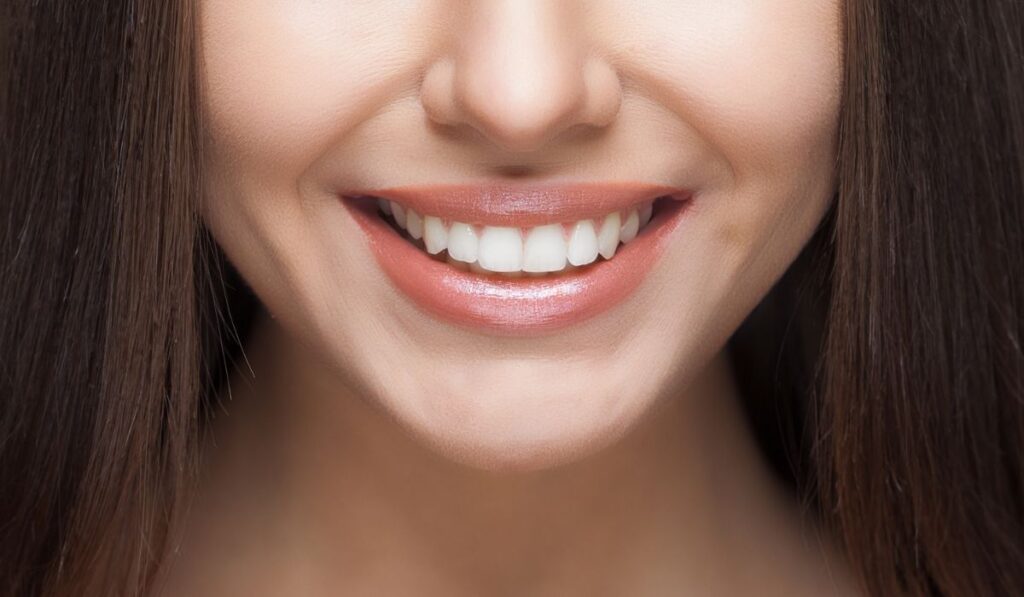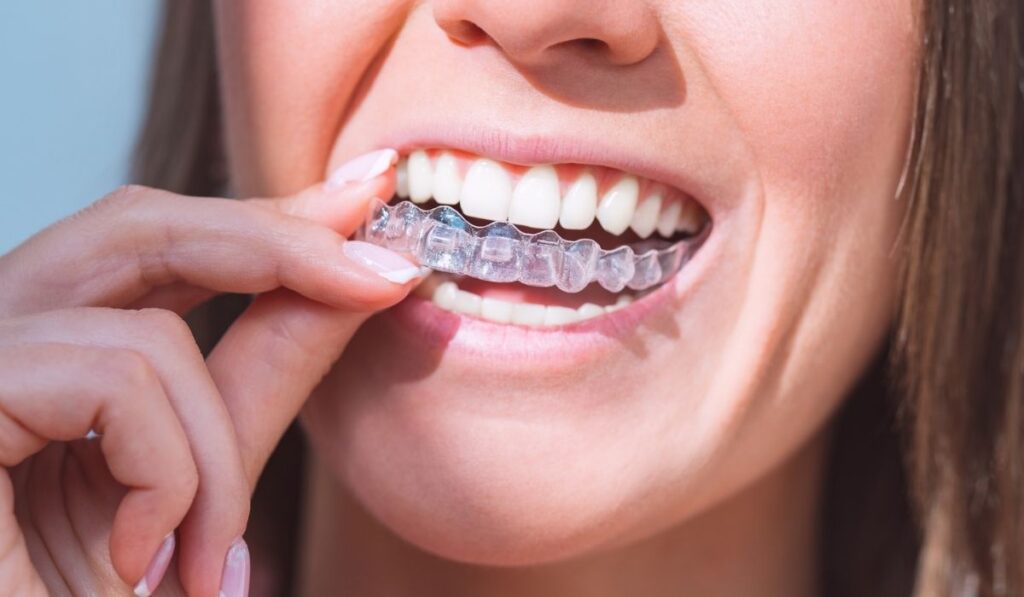While wearing braces is a nightmare for many, living with crooked and misaligned teeth can also be a challenge. Crooked teeth can increase the risk for cavities and periodontal disease, since it makes it harder to maintain optimal oral health. Teeth that don’t fit societal beauty standards can also take a toll on a person’s confidence and self-esteem. This is where the need to straighten teeth comes in. Luckily, wearing braces is not the only option for those looking to get their teeth straightened.
Instead of braces, you can straighten your teeth with invisible aligners, dental procedures like veneers and crowns, retainers, and in some cases surgery. You should consult with an orthodontist to figure out a medically-approved plan. DIY methods can leave your teeth permanently damaged.
Although crooked teeth are already a reality for many people, it is also possible to prevent crooked teeth in the first place. By replacing unhealthy habits, such as oral fixations, with healthier ones, you can reduce the chances of misalignment. These unhealthy habits usually start in childhood but it’s never too late to fix them. Let’s take a look at the various options for straightening your teeth and how to keep them straight in the long run.
Can You Straighten Your Teeth Naturally?

There is no guaranteed way of naturally straightening teeth, and most of the advertised techniques are dangerous and counterproductive.
Even though you can help prevent crooked teeth by getting rid of unhealthy habits, there is very little you can do to straighten them once they are already misaligned and crooked.
You should not attempt any straightening hacks that involve the use of household tools or at-home kits provided by an alleged teeth-straightening company. If you have crooked teeth and want to get them aligned, you should consult an orthodontist and only take routes that they approve of.
The only effective way to straighten teeth is through orthodontic procedures. But that does not mean you have to be stuck with braces. There are many alternatives to braces that are faster, more convenient, and more comfortable.
Some of them are even invisible, meaning you don’t have to compromise on how you look as you wait for your teeth to be straightened.
Are DIY Braces Safe?
No, DIY braces are not safe, and they pose a real threat of permanent damage to your teeth. The process of designing, testing, shaping, and fitting braces over crooked teeth is a complex one, refined over the years by researchers and specialists after decades of trial and error.
Even though there are many more alternatives to braces and straightening techniques available today than there were before, it is tempting to evade the cost of the procedure and try something quirky at home. However, it is simply not worth it to subject your teeth to such trauma.
There are many forms of DIY braces recipes available on the internet, ranging from glued rubber bands to at-home printed Invisalign models. Each of these DIY braces have hundreds of reports of having gone wrong.
In one such report, a rubber band was found lodged between the gum and the tooth and resulted in permanent loss of the tooth. You don’t want that to happen to you.
Regardless of what shape they take, DIY braces are not only harmful and unsafe but also ineffective. They will damage your gums, teeth, and jaw at worst and waste your time and effort at best.
Best Methods to Straighten Your Teeth Without Braces

In the face of sky-high costs for braces, having the perfect teeth and the perfect smile can seem like an unattainable goal. But it truly is not. There are plenty of ways you can straighten your teeth without subjecting your jaw to the horrors of having braces for months, or in some cases, years.
The best ways to straighten your teeth without braces include cosmetic adjustments through clear, invisible aligners such as Invisalign and Byte, cosmetic dentistry procedures such as crowning and veneering, and surgical procedures involving the removal of teeth.
Let’s take a look at the best teeth straightening alternatives to braces:
Invisible Aligners
Some people find braces repulsive because of their visibility. Their wire structure is also often perceived as a source of pain and discomfort, making them undesirable for those looking to straighten their teeth. This is where hidden, invisible aligners come in.
Clear, plastic aligners work in the same way that braces do except they are transparent and cannot be seen. Because they are made up of plastic instead of metal, they are also softer and less painful to wear. Unlike normal orthodontic braces, invisible aligners can be removed at will.
Invisible aligners are generally quicker and more effective than braces if used properly. They are used as part of a treatment consisting of different stages of aligners. Every two weeks, the invisible aligner is changed for the next one on the list.
On average, invisible aligners must be worn for at least 22 hours every day and only removed for food consumption or brushing. Invisible aligners are custom-made and fitted to the contours of the jaw with the help of 3D mapping. This is what makes them so effective but also what makes them expensive to get in the first place.
Invisible aligners are now commonly available, with Invisalign attributed as the oldest and most widely known option for its invisible treatment. Byte and Candid are also two of the other top brands known for their invisible aligners.
Clear, plastic aligners that are invisible to the eye but are effective are your best bet against braces. They might be a bit pricey, but they yield quicker results than normal orthodontic braces.
Still, not every patient will be a candidate for clear Invisalign aligners, depending on the severity of their misalignment. If you have an open bite or improper bite patterns, braces may be inevitable.
Dental Veneers
Veneering is a part of cosmetic dentistry that focuses on straightening and aligning teeth without the use of braces. Dental veneers are also sometimes referred to as dental bonding. Veneering involves the bonding or attachment of thin, hard shells of porcelain to the front side of affected teeth.
The veneers help to correct misaligned teeth and fix their crookedness. They are also used for other purposes such as fixing chipped teeth or getting rid of discoloration. They are permanent and require maintenance. They might also need to be replaced every five to ten years.
Though they are not as visible and painful as constantly wearing braces, veneering involves the irreversible altering of teeth. The natural surface enamel of affected teeth has to be removed before veneers can be bonded. Naturally, this process is both complex and costly.
Dental Crowns
Similar to dental veneers, crowning is a permanent dental procedure that involves the placement of artificial crowns over the top of the teeth. These crowns act as caps that hide the original misshapen teeth, replacing them with perfect-looking artificial ones.
Dental crowns can be used to straighten crooked and chipped teeth. Unlike other crowning procedures that usually involve the removal of a damaged tooth before insertion of a crown, cosmetic crowning involves shaving down the misaligned tooth to fit the contour of the aligning crown.
Because it involves drilling down on natural teeth, cosmetic crowning is often not recommended and discouraged as an alternative way to straighten crooked and misaligned teeth.
Dental procedures like crowning also have limited utility and they might not be very useful in cases like overbites or other severe cases of misalignment.
Hence, they are uncommon, more expensive, and come with their own set of risks.
Retainers
Less extreme than surgery or dental procedures like veneering or crowning, retainers are like clear plastic aligners except even simpler. They can only be used as alternatives to braces if the teeth need minimal correction. Otherwise, they are used once the treatment with braces is complete as a way to cement the newly-aligned teeth in place.
Unlike braces, retainers are made out of clear plastic that fits perfectly over the teeth and is invisible to the eye. But they are also not as effective as clear, invisible aligners which are custom-made to fit the jaw and move teeth to their correct positions.
Therefore, retainers are not considered effective for strict alignment purposes and are only used in the aftermath of more rigorous treatments.
Given their utility, it is no surprise that retainers are cheaper and far more accessible than other methods on this list.
Incognito Hidden Braces
Sometimes getting braces appears to be the only way to straighten your teeth. However, this does not mean that the only option is wired braces that are visible for everyone to see.
Incognito or hidden braces are exactly the same as traditional braces except they are attached to the back of the teeth instead of the front, meaning that nobody will know you have braces until you tell them.
Apart from having no impact on your smile, hidden braces also do not interfere with speech, making them much more comfortable and convenient than the traditional ones. Hence, they are the best option for those who are conscious about their teeth but cannot be helped by other options.
Surgery
Sometimes, aligners are not enough, dental procedures can’t fix the problem, and maybe even the braces won’t cut it. In such cases, surgery is considered the only viable option to remove unwanted teeth, bring the rest into alignment, and straighten the crooked ones. Teeth that cause crowding, such as those called peg teeth, can require surgery.
Teeth straightening surgeries are also useful for fixing misaligned jaws and over or underbites. Unlike procedures that are performed on teeth, alignment surgeries are often performed on the jaw by oral surgeons. Therefore, they are skeletal surgeries rather than dental surgeries.
Surgeries are employed for problems that cannot be fixed by braces and are not really considered an alternative. They are only required when misalignment of teeth is caused by underlying jaw problems rather than the crookedness of the teeth themselves.
How to Prevent Crooked Teeth in the First Place
Even though there are corrective dental procedures that can be performed to straighten teeth, preventing crooked teeth in the first place can save you a lot of trouble, despair, and money.
Crooked teeth are not entirely natural. They can be developed over time due to a number of unhealthy habits. This section provides some techniques for the natural prevention of crooked teeth.
Do Not Sleep on Your Stomach
Sleeping on your stomach increases the crookedness of the teeth. This is because when you sleep on your stomach, your face has to bear a lot of the weight of the body. This weight exerts pressure on your mouth and pushes your teeth inwards. The result of this pressure is the overcrowding and inner overlapping of teeth.
Sleeping on your stomach can have even worse effects on your teeth if you sleep with something hard like an arm or a firm cushion placed under your face. Doing so increases the pressure exerted by your weight and also increases the likelihood of your teeth being overcrowded.
If you want to prevent crooked teeth in the first place, develop a habit of sleeping either on your back or your side. Otherwise, your face-down sleeping position will slowly exert pressure on your teeth and cause them to reposition.
Do Not Lean on Your Face
The same way sleeping on your stomach exerts pressure on your teeth and mouth, extensively leaning on your face with your hand also results in consistent pressure being exerted on one side of the jaw.
This asymmetrical application of pressure gently pushes teeth on top of each other, causing crowding and crooked teeth.
Leaning on your face by resting it on your hand is a result of bad posture and most people do it without even realizing it, especially when their work requires prolonged periods of being seated on a desk.
The best way to avoid this is to consciously maintain a good posture by keeping your back straight and supported.
If you keep your lower body well supported, you will not experience sore shoulders or a sore neck, thereby eliminating the need to rest on your hands. Doing so will remove the persistent, imbalanced application of pressure on your jaw, preventing crooked teeth in the long run.
Get Rid of Unhealthy Oral Fixations
Unhealthy habits and fixations, particularly those concerning your mouth, can have detrimental long-term effects on your teeth. One common habit is that of thumb sucking, which tends to push the front teeth outwards over time.
Thumb sucking is an example of one of the most damaging oral fixations that apply persistent pressure to the front teeth, resulting in repositioning, crookedness, and an overbite.
While sucking the thumb as a child can affect the alignment of the teeth, thumb sucking as an adult is more detrimental as it can permanently reshape the teeth’s alignment.
A similar oral fixation that some people do but barely realize is chewing on a pen or pencil.
Fix the Gap Between Teeth
While it’s normal to have space or a gap between teeth, the space and gap left behind by missing teeth can cause the remaining teeth to become crooked and get out of alignment. This obviously does not apply to baby teeth that naturally fall out to give way to permanent ones.
The loss of teeth in adulthood due to reasons like dental diseases, injuries, or extractions can result in the uneven distribution of pressure during chewing, causing the surrounding teeth to bear larger than usual force.
This eventually leads to the remaining teeth getting skewed and becoming crooked. Teeth are also naturally prone to move forward to fill in gaps in the denture in a process called “mesialization.”
Attending to missing teeth as soon as possible is the best way to prevent your other teeth from getting negatively impacted. A wide range of dental procedures is commonly available to fix such issues including but not limited to the installation of dental implants, bridges, and dentures.
Monitor Your Wisdom Teeth
Wisdom teeth, specifically those that get impacted or embedded within the gum, can be a source of great pain and discomfort. But more than that, they can also severely disturb the alignment of your teeth and result in crooked and misshapen teeth.
Even though there is no scientific backing to this claim, it is reasonable to believe that emerging wisdom teeth will inadvertently lead to crowding of the jaw. This is particularly concerning because there is no one way that wisdom teeth tend to emerge.
Wisdom teeth grow out in different directions and if they emerge in certain ways, it can either cause normal teeth to become crooked or exacerbate the existing crowding of teeth.
The best way to prevent an undesirable situation with wisdom teeth is to regularly visit your dentist and have your teeth inspected for any irregularities. Most wisdom teeth will need to be removed once they begin to appear in x-rays.


